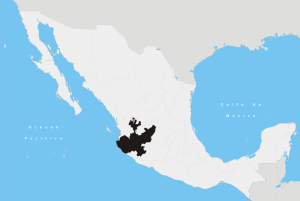Tlaquepaque
Tlaquepaque (Spanish pronunciation: [tlakeˈpake]), historically San Pedro Tlaquepaque, is a city and the surrounding municipality in the Mexican state of Jalisco.
Tlaquepaque | |
|---|---|
| San Pedro Tlaquepaque | |
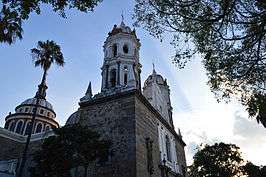  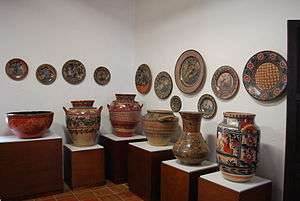 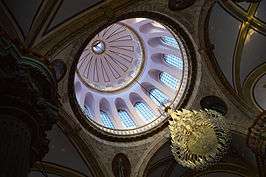 San Pedro Tlaquepaque | |
 Flag 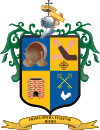 Coat of arms | |
| Nickname(s): | |
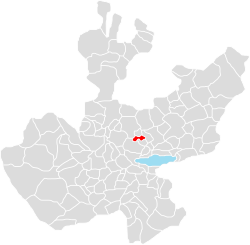 | |
 Tlaquepaque | |
| Coordinates: 20°37′N 103°19′W | |
| Country | |
| State | |
| Region | Centro |
| Municipality | Tlaquepaque |
| Foundation | 25 March 1530 |
| Government | |
| • Mayor | María Elena Limón (Citizens' Movement (Mexico)) |
| Area | |
| • City | 270 km2 (100 sq mi) |
| Elevation | 1,870 m (6,140 ft) |
| Population (2010) | |
| • City | 575,942 |
| • Density | 2,100/km2 (5,500/sq mi) |
| • Metro | 4,424,252 |
| • Metro density | 1,583/km2 (4,100/sq mi) |
| Demonym(s) | Tlaquepaquense |
| Time zone | UTC−6 (CST) |
| • Summer (DST) | UTC−5 (CDT) |
| Website | https://www.tlaquepaque.gob.mx/ |
Geography
During the 20th century, it was absorbed by the outward spread of the state capital, and is now a fully integrated part of the Guadalajara conurbation, lying only a few kilometers from the city center. The city had a 2010 census population of 575,942, making it the third largest city in the state, behind only Guadalajara proper, and Zapopan, another city in the metro area. The municipality's area is 270.88 km2 (104.59 sq mi) and lies adjacent to the south side of Guadalajara. Its largest community besides Tlaquepaque is the town of Santa Anita, at the municipality's southwestern corner.
Climate
The climate of the municipality is semi-dry with dry winter and spring, semi-warm without defined winter season. The average annual temperature is 20.7 -C, and has an average annual rainfall of 919 millimeters with a rain regime in the months of June to August. The prevailing winds are in a southeasterly direction. The average number of frost days per year is 5.2.
Natural Resources
It currently has a few forest areas where species of acacia, palo dulce and granjeno predominate. The native fauna is composed of rabbits, hares, squirrels, reptiles, and various bird species in the region.
Hydrography
The municipality has no river, has streams with the most outstanding being El Seco, Sebastianito and New Spain. Previously there were the dams Las Lomas, La Ladrillera, Las Pintas and Las Rusias. Most of the land has an urban use and the is held as private property.
Geology
Lithologically, the municipality was formed in the Quaternary period and is composed of pumitic tobas (commonly known as pumice stone that are made up of explosion products such as lapillis, puzolanas and ash. The predominant soils belong to the type haplic feozem and planosol eútric. An associated soil is the planepeloic sun.
Economy
In the agricultural field the crops of maize, sorghum, sweet potato, onion, kale, lettuce and betabel stand out. In livestock, there are farms where meat and milk are reared, porcino-porcino cattle, sheep-sheep, goat-goat, poultry and posture, and beekeeping-beehives.
The main industrial branch is manufacturing, handicrafts, papier-mache, glass, brass, pottery, yarn, mud, leather and wood. Within the municipality are located several industrial parks, in which they house different national and transnational plants, such as:
- HP (printers and computers)
- Bimbo (breadmakers)
- Lala (milk and dairy products)
- José Cuervo (tequila)
History
The name Tlaquepaque derives from Nahuatl and means "place above clay land". The area is famous for its pottery and blown glass. Before the Spaniards arrived on these lands, the Toluquilla, Zalatitán, Coyula, Tateposco, Tlaquepaque, Tapechi (Tepetitlán), and Tequepexpan, formed with Tonalá a kingdom, ruled by a woman named Cihualpilli Tzapotzinco. It was inhabited by Tonalteca Indians and later by the tecos that were in place at the arrival of the Spaniards. It was a pre-Hispanic town settled on a hill where they built houses of grass, reaching 500 inhabitants. In March 1530 he arrived in these lands Nuño de Guzmán and his people, entering San Martín de las Flores, formerly called Tlaxicoltzingo. Knowing the natives of the approach of the Spaniards, they were divided into two sides, because while Queen Cihualpilli and some gentlemen opted to give them a peaceful reception given their invincible power, others pretended to be resisted. The supporters of peace sent to the meeting of the Spaniards a delegation composed of nobles and rulers of the various peoples of the kingdom. From the town of Tlaquepaque were Coyotl, Chitacotl and Tonatl, Xonatic, Cuauhuntin and Oceotl, from the town of Tetlán, Coyopitzantli from Tzalatitán, Timoac and Oxatl, from Atemaxac, Ipac, from Ichcatlán, and Tzacamitl from Xocatic gift of chickens, eggs, honey, ahuacates, onions and some fruits to tell them that they already had news of their coming and that they were waiting for them amicably Guzmán well received by the Queen of Tonalá, being baptized with the name of Juana Bautista Danza. This name was the winner of a raffle that made names such as Petra, Micaela and Juana. Dance was chosen because it arranged a dance in honor of the Spaniards. Before entering the city, it sent several of its men to require the rebels who obtained in response a great shouting and a rain of arrows. Those who opposed confronted Guzman's army; The result of the meeting was unfavorable for the natives of the earth. All the rebels were captained by the lord of Tetlan, Tlaquitehuitli, and also by the Indian nobles Cuautipizahuac, and Catipamatac. On 25 March 1530, Nuño de Guzmán took possession of the kingdom of Tonalá and the subject peoples, including Tlaquepaque. In 1548, the town received the name of San Pedro, at the suggestion of Fray Antonio de Segovia, and during the colonial era and throughout the nineteenth century, he was only known by that name. From the second half of the sixteenth century it acquired the character of corregimiento subject to the jurisdiction of the city of Guadalajara. Once the Spaniards settled in Guadalajara, they began to exercise political and religious control in the surrounding towns, and the authorities of the incipient Pearl Tapatia ordered that San Pedro deliver a tribute according to the number of inhabitants and in accordance with their occupations. In that way, in 1551 they came and made the order clear to the encomendero that this tribute be fulfilled. San Pedro, according to the same census that was taken for the tax transaction, had 1416 inhabitants living in 177 jacales. The tribute they imposed was four loads of grass a day, ten chickens from Castile, ten loads of firewood and five service Indians a week, thirty blankets, forty tapatios, twenty pairs of quills, six loaves of salt and two jugs of honey, every two months, and four hundred hanegas of corn and twenty hanegas of chili every year. In the year 1600, San Pedro had fewer inhabitants than Toluquilla, which today belongs to Tlaquepaque. Alonso de la Mota and Escobar said:
Leaving, then, from Guadalajara on the road that falls further to the east, one goes to the town of San Pedro of one hundred Indian neighbors
By 1621, San Pedro was a doctrine of Franciscan religious from the convent of Guadalajara. On the morning of 26 November 1810, Hidalgo made his entrance to San Pedro where he was presented with a feast, and in the afternoon he entered the capital triumphantly.
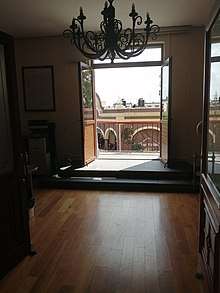
The priest Miguel Hidalgo y Costilla arrives in San Pedro Tlaquepaque, on Sunday, 25 November, from Atequiza jal. It was arranged to take for your best comfort, the most comfortable house, you will be served a great banquet at noon, and at night a refreshment with all visitors, from the church and the government. Making preparations to leave San Pedro Tlaquepaque towards the capital today Guadalajara with around 7,000 men. Arriving around noon at the gates of the cathedral. In 1821, San Pedro Tlaquepaque was the cradle of the proclamation of the 'Independence of Jalisco' by the brigadier Pedro Celestino Negrete, since the document is signed in the town on 13 June of the same year . According to the decree of 27 March 1824, San Pedro became a member of the Guadalajara Department. In 1825, San Pedro is registered as a town.
Government
Mayors
| Term | Mayor | Political Party | Note |
|---|---|---|---|
| 1857-1861[1] | Santiago García | ||
| 1861 | Luis Hernández | ||
| 1862 | Luciano Martínez | ||
| 1862 | Reyes García | ||
| 1862-1863 | Martín Manzano | ||
| 1863 | Reyes García | ||
| 1863 | Martín Manzano | ||
| 1863-1867 | Julián González | ||
| 1868 | José María Zúñiga | ||
| 1869 | Eligio Zúñiga | ||
| 1869-1870 | Exiquio Cortés | ||
| 1870 | Andrés Martínez | ||
| 1870 | Apolonio Ramírez | ||
| 1870 | Andrés Martínez | ||
| 1870 | Faustino Preciado | ||
| 1870 | Andrés Martínez | ||
| 1870 | Fausto Preciado | ||
| 1871-1873 | Regino Guillén | ||
| 1874-1876 | Brigido Rosales | ||
| 1876 | José G. Azco | ||
| 1876 | Mateo Gómez | ||
| 1877 | Jorge Tiznado | ||
| 1877 | Brígido Rosales | ||
| 1877 | Amado Goche | ||
| 1878 | Enrique V. Loza | ||
| 1878 | José Alemán | ||
| 1878-1879 | Ramón Gómez | ||
| 1880 | José Hernán | ||
| 1880 | Trinidad Hernández | ||
| 1880-1881 | José María Ivanz Alatorre | ||
| 1881 | Trinidad Hernández | ||
| 1881-1883 | José Guarro | ||
| 1883 | Francisco Muñoz Gutiérrez | ||
| 1883 | Donato Rosales | ||
| 1887 | Guadalupe Serratos | ||
| 1887 | Juan N. Curiel | ||
| 1887-1888 | Guadalupe Serratos | ||
| 1888 | Luis Medina | ||
| 1888 | Ramón A. Alatorre | ||
| 1888-1890 | J. Macías Gutiérrez | ||
| 1890 | J. Hernández | ||
| 1890-1891 | L. G. Degollado | ||
| 1891 | R. Y. Navarro | ||
| 1892 | Antonio Ortiz Gordoa | ||
| 1892-1893 | Ignacio G. Ruvalcaba | ||
| 1893 | Cruz Gómez Bordón | ||
| 1893 | Adolfo Baldomero Riestra | ||
| 1893 | José P. Jarero | ||
| 1893 | Dávalos | ||
| 1893 | Bernardo Topete | ||
| 1894 | Cruz Gómez Bordón | ||
| 1894 | Bernardo Topete | ||
| 1894 | Manuel Rodríguez | ||
| 1895 | Antonio Muñana | ||
| 1895 | Bernardo Topete | ||
| 1895 | José González | ||
| 1895-1896 | Antonio Muñana | ||
| 1896-1897 | Luciano J. Gallardo | ||
| 1897 | Mariano Jiménez | ||
| 1897-1898 | Carlos Marrón | ||
| 1898-1899 | Miguel Y. Morales | ||
| 1899-1900 | Pedro Zúñiga | ||
| 1900 | Enrique Barrios de los Ríos | ||
| 1900 | Roberto Robles | ||
| 1902 | Luis Navarrete | ||
| 1902 | Anastasio Gallo | ||
| 1902-1905 | B. Gómez Cruz | ||
| 1905-1907 | Rafael del Castillo | ||
| 1907-1908 | O. Jiménez | ||
| 1908 | Pedro Cantú | ||
| 1908-1910 | J. López Portillo Camarena | ||
| 1910-1911 | Manuel Argaiz | ||
| 1911 | Maximino Campos | ||
| 1911-1912 | Jesús Álvarez del Castillo | ||
| 1912 | Mateo de León | ||
| 1912 | Egberto de la Mora | ||
| 1912-1914 | Luis Rubio Luquín | ||
| 1914 | Alberto Corona | ||
| 1914 | J. López Portillo Camarena | ||
| 1914 | Anastasio Gallo | ||
| 1914 | Jerónimo Sahagún Campos | ||
| 1914-1915 | Alejandro Aviña | ||
| 1915 | Samuel Acuña | ||
| 1915 | Mariano Castellano | ||
| 1915 | Pedro Patiño Navarro | ||
| 1915 | Galindo Flores | ||
| 1915-1917 | Leocadio Muñoz | ||
| 1918-1919 | Félix G. Acosta | ||
| 1919 | Fernando Rosas Merino | ||
| 1919-1920 | Eleuterio Plascencia | ||
| 1920 | Emilio Trujillo | ||
| 1920 | Luis Álvarez del Castillo | ||
| 1920 | Salvador Farías | ||
| 1920 | ¿? | ||
| 1921 | Gerónimo Sahagún | ||
| 1921 | Fernando Rosas Merino | ||
| 1922-1924 | Antonio Sánchez | ||
| 1924 | I. M. Salcedo | ||
| 1924 | Juan Panduro | ||
| 1924 | Ochoa | ||
| 1925-1926 | Adrián Morales | ||
| 1927-1928 | Antonio Sánchez | ||
| 1929 | N. Ramírez | PNR | |
| 1930 | Gerónimo Sahagún | PNR | |
| 1931 | Roberto Gómez Vallejo | PNR | |
| 1932 | C. G. Rodríguez | PNR | |
| 1933 | Gerónimo Sahagún | PNR | |
| 1934 | Ignacio Orozco | PNR | |
| 1935-1936 | David Mendoza | PNR | |
| 1937 | Ignacio Orozco | PNR | |
| 1938-1939 | Roberto Gómez Vallejo | PRM | |
| 1940 | Fernando Silva | PRM | |
| 1941-1942 | Manuel Talamantes | PRM | |
| 1943-1944 | Manuel Izquierdo | PRM | |
| 1945 | Aurelio G. Ramírez | PRM | |
| 1945 | Francisco Talamantes | PRM | |
| 1946 | J. Jesús Castellanos | PRI | |
| 1946 | J. Cruz Valencia | PRI | |
| 1947-1948 | José Loza Sánchez | PRI | |
| 1949-1952 | J. Jesús Ruvalcaba | PRI | |
| 1953-1955 | Jerónimo Sahagún | PRI | |
| 1956-1957 | Anastasio Salas | PRI | |
| 1958 | Antonio Gutiérrez Ortiz | PRI | |
| 1959-1961 | Rubén Casillas Ramírez | PRI | |
| 1962-1964 | Javier Valdivia Hernández | PRI | |
| 01/01/1965-31/12/1967 | Simón Sánchez | PRI | |
| 01/01/1968-1970 | Lauro Vadillo Díaz | PRI | |
| 1970-31/12/1970 | J. Guadalupe Gómez de la Torre | PRI | |
| 01/01/1971-31/12/1973 | Roberto Neri Rodríguez | PRI | |
| 01/01/1974-31/12/1976 | Javier Valdivia Hernández | PRI | |
| 01/01/1977-1979 | Marcos Montero Ruiz | PRI | |
| 1979-31/12/1979 | Pedro Martínez López | PRI | |
| 01/01/1980-31/12/1982 | Salvador Orozco Loreto | PRI | |
| 01/01/1983-1985 | Porfirio Cortés Silva | PRI | |
| 1985-31/12/1985 | José Isiordia Fierros | PRI | Acting Mayor |
| 01/01/1986-31/12/1988 | Arturo Franco Lozano | PRI | |
| 01/01/1989-1991 | Alfredo Barba Hernández | PRI | |
| 1991-1992 | Salvador Casillas Tostado | PRI | |
| 1992-1995 | Eduardo Riverón Gámez | PRI | |
| 1995-1997 | Marcos Rosas Romero | PAN | |
| 01/01/1998-31/12/2000 | José María Robles Díaz | PAN | |
| 01/01/2001-31/12/2003 | José Antonio Álvarez Hernández | PAN | |
| 01/01/2004-31/12/2006 | Miguel Castro Reynoso | PRI | |
| 01/01/2007-31/12/2009 | José Hernán Cortés Berumen | PAN | |
| 01/01/2010-30/09/2012 | Miguel Castro Reynoso | PRI | |
| 01/10/2012-30/09/2015 | Alfredo Barba Mariscal | PRI | |
| 01/10/2015- | María Elena Limón García | MC | She was reelected on 01/07/2018. Her second triennium started 01/10/2018 |
Cultural Center El Refugio
In 1859, Fray Luis Argüello Bernal was given the task of designing, sponsoring and building a hospital and house of spiritual exercises that was named "El Refugio" and "Casa de la Salud Josefina", (since it was administered by the Religious Josefinas until 1935), this with the financing of the Brotherhood of San Vicente de Paul, in addition to the contributions of the neighborhood of San Pedro, as well as the wealthy families of Guadalajara who had their summer homes in San Pedro Tlaquepaque. Its construction is colonial style of approximately 10,000 m².
In the year of 1979 it was closed, and after being abandoned for a long time, the construction was acquired by the Municipal Administration of Tlaquepaque of Mr. Porfirio Cortés Silva in 1983; and rescued, renovated and modified in 1984 by the Architect Alejandro Zhon, in order to carry out the Cultural Center "The Refuge" who was responsible for carrying out the rehabilitation work, which retained the original architecture of the building, highlighting its lengths corridors and large patios, making it a Cultural, Commercial, Craft and Tourist Center. [2]
Tourism
It is a resort focused on the crafts of pottery, textiles and [blowing glass]. Its streets and walkers are adorned with various Casonas of the last century, in addition to colonial constructions, the Tapatío Tour arrives at the municipality on one of its routes. The main attractions in the municipal head are:
- St. Peter's Parish - enclosure built by the Franciscan Order, which receives the category of Parish in 1845, constitutes one of the spiritual pillars of San Pedro Tlaquepaque. Its construction is a mixture of styles, including: Byzantine, Baroque and Roman. At the front is the terminus of St. John Paul II.
- Hidalgo Garden - with its square and kiosk surrounded by fresh palms, ash and roses
- Municipal Palace - this colonial building dates from the nineteenth century. Currently, it is used as administrative and government offices of San Pedro Tlaquepaque. On the second floor is the mural "Historia de Fuego" by the artist Camilo Ramírez and the large format painting "Yolotl" by Eusebio Sánchez Benítez; worthy of admiration.
- El Parián - This famous and typical building that characterizes San Pedro Tlaquepaque is a place of family gathering and recreation and place for civic and social festivities. It currently has 18 restaurants and bars.
- Andador Independencia. - Andador with art galleries, artisan shops, old houses, the Regional Ceramics Museum, bars and restaurants.
- Centro Cultural el Refugio.- in 1885, Fray Argoello began the construction of this building, which functioned as a general and psychiatric hospital and was built in various stages. Currently, it is the Center for Congresses, Conventions, Exhibitions and Special Events. In its facilities are the School of Plastic Arts, Crafts and Crafts "Angel Carranza" and the Museum of the National Prize for Ceramics "Pantaleón Panduro".
- El Refugio Cultural Center.
- Panduro Pantaleon Museum. - Museum of the National Prize for Ceramics "Pantaleón Panduro".- The museum is located on the premises of the Cultural Center el Refugio. It houses the winning pieces of the National Prize for Ceramics, the same from different states of the Mexican Republic.
- Regional Ceramics Museum - The Museum has eight exhibition halls, containing pieces from different regions of Jalisco and Mexico; including the miniatures of the Tlaquepanse Angel Carranza. In addition, an extra room, is dedicated to art and culture exhibitions.
- Parish of San Pedro Tlaquepaque
- Juarez Street.
- Sanctuary of the Holy Mexican Martyrs - The martyrs gave their lives for Christ and for Our Lady, so this sanctuary fulfills the mission of remembering those who with their blood fed the faith of the Mexican people. In fact, most of these martyrs were from Guadalajara or passed through this city during the persecution of the 1920s. Today, recalls Héctor Castellanos, the Guadalajara seminary has about 1,000 seminarians and is one of the most important in the world. The origin of the construction has a double slope, on the one hand because of the needs of the Diocese when it comes to mass acts, and on the other of a desire of St. John Paul II to investigate and give value to the Mexican victims of religious persecution.
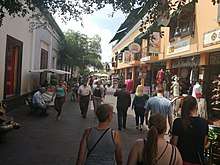
Main sights
Tlaquepaque features El Parián, a large plaza flanked by columned arcades and surrounded by restaurants and bars. The main square in the city centre is known as El Jardín Hidalgo ("Hidalgo Garden"), named after Miguel Hidalgo y Costilla, the "Father of Mexican Independence." A larger-than-life statue of Hidalgo dominates the square. Other main features include the two important churches, El Santuario de Nuestra Señora de la Soledad (The Sanctuary of Our Lady of Solitude) and San Pedro (Saint Peter), and the Benito Juárez market.
Culture
Tlaquepaque is known for its mariachi bands. During the annual San Pedro festivities, El Jardín is filled with stalls and street sellers. On the day of San Pedro itself, towering firework-festooned structures known as the Castillo ("castle") and Toro ("bull") are set alight.
Etymology
The native name has its etymology in the same land. The word "Tlaquepaque" means "Place on knolls of clay land," although there are other versions that are inclined to "men who craft clay pieces ("Tlacapan")". For others the word "Tlaquepaque" comes from the word "Tlalipac", "on mud knolls". Yet another etymology says that it means "place of mud."


Recovery of the original name
as established in the initiative that the municipal president sent to the State Congress, in 1843 San Pedro Tlaquepaque was granted the category of Villa, a name he kept until 1917, when by decree of the then governor Manuel Aguirre Berlanga, prohibited in Jalisco using the name of saints in streets, squares, parks, as well as "living people, animals or other frivolous designations". The ban did not include municipalities, but San Pedro Tlaquepaque lost the first part of its original name. Currently, the municipality of Tlaquepaque recovered its full name San Pedro Tlaquepaque, an initiative carried out by the municipal president, Miguel Castro Reynoso. Before seeking recovery, the City Council of Tlaquepaque carried out a consultation between residents of the municipality, both the head and other delegations. The polls were available to citizens from 20 September to 8 October 2010 and 13,043 people participated. The result was that 62.4 percent of the people consulted are in favor of the municipality being renamed San Pedro Tlaquepaque; 37.2 percent to stay as is and 0.4 percent did not answer. The results of the consultation were the basis for the agreement that the plenary session of the City of Tlaquepaque took on 11 November 2010, through which the municipal president was authorized to present to the State Congress an initiative to request the name change, as well as the modification of article 4 of the Law of Government and Municipal Public Administration, which establishes the list of municipalities that make up Jalisco. On 21 June 2011, the Constitutional Points Commission of the State Congress approved the opinion through which the name change is authorized, so on 27 September 2011 the State Congress approved that the municipality of Tlaquepaque return to its original name, that is, San Pedro.
Tlaquepaque is also known for its famous tepache, a partially fermented drink made with pineapple, brown sugar and water.
Sister cities
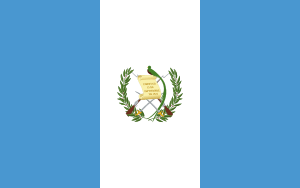










References
- "Enciclopedia de los Municipios y Delegaciones de México. Estado de Jalisco. Tlaquepaque" (in Spanish). Retrieved 24 May 2020.
- https://web.archive.org/web/20110405125729/http://www.tlaquepaque.gob.mx/site/node/ 218
- "Interactive City Directory". Sister Cities International. Retrieved 11 March 2014.
- Se unen Tlaquepaque y Cozumel..., Retrieved 25 January 2015
- Link to tables of population data from Census of 2005 INEGI: Instituto Nacional de Estadística, Geografía e Informática
- Jalisco Enciclopedia de los Municipios de México
External links

- Municipio de Tlaquepaque Official website
- Directorio de artesanos y artesanias Handcraft producers
